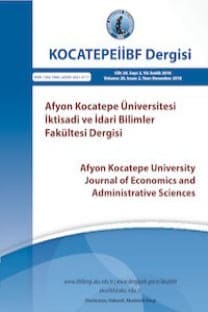FORTUNE 500 LİSTESİNDE YER ALAN LOJİSTİK FİRMALARIN DEĞERLENDİRİLMESİ
Çok Kriterli Karar Verme, ÇKKV, Lojistik, Gri İlişkisel Analiz, GİA, SWARA, COPRAS, TOPSIS
EVALUATION OF THE LOGISTICS COMPANIES ON THE LIST OF FORTUNE 500
Multi Criteria Decision Making, Logistics, Gray Relational Analysis, SWARA, COPRAS, TOPSIS,
___
- Alfaro, J., Ortiz, A. ve Poler, R. (2007), “Performance Measurement System for Business Processes”, Production Planning Control, 18(8), 641-654.
- Başdeğirmen, A. ve Tunca, M. Z. (2017), “Lojistik Sektöründe Faaliyet Gösteren İşletmelerin Finansal Performanslarının Gri İlişkisel Analiz İle Değerlendirilmesi”, SDÜ, İİBF Dergisi, 22(2), 327-340.
- Çakir, S. ve Perçin, S. (2013), “Çok Kriterli Karar Verme Teknikleriyle Lojistik Firmalarında Performans Ölçümü”, Ege Akademik Bakış, 13(4), 449-459.
- Cheng, S., Chan, C. W. ve Huang G. H. (2002), “Using Multiple Criteria Decision Analysis for Supporting Decisions of Solid Waste Management”, Journal of Environment Science Health, Part A, 37(6), 975-990.
- Fortune (2017), http://www.fortuneturkey.com/fortune500, (17.10.2017).
- Jharkharia, S. ve Shankar, R. (2007), “Selection of logistics service provider: An analytic network Process (ANP) approach”, International Journal of Management Science, 35, 274 – 289.
- Kaklauskas, A., Zavadskas, E. K. ve Raslanas, S. (2005), “Multivariant design and multiple criteria analysis of building refurbishments”, Energy and Buildings, 37(4), 361-372.
- Keršulienė, V. ve Turskis, Z. (2011), “Integrated fuzzy multiple criteria decision making model for architect selection”, Technological and Economic Development of Economy, 17(4), 645-666.
- Keršulienė, V., Zavadskas, E. K. ve Turskis, Z. (2010), “Selection of rational dispute resolution method by applying new step-wise weight assessment ratio analysis (SWARA)”, Journal of Business Economics and Management, 11(2), 243-258.
- Lambert, D. M., Stock, J. R. ve Ellram, L. M. (1998), Fundamentals Of Logistics Management, USA: Irwin -Mc Graw Hill.
- Meade, L. ve Sarkis, J. (2002), “A conceptual model for selecting and evaluating third-party reverse logistics providers”, Supply Chain Management: An International Journal, 7(5), 283-295.
- Min, H. ve Joo, S. J. (2006), “Benchmarking the operational efficiency of third party logistics using data envelopment Analysis”, Supply Chain Management, 11(3), 259–265.
- Özbek, A. (2017), Çok Kriterli Karar Verme Yöntemleri ve Excel İle Problem Çözümü. 1. Baskı, Ankara: Seçkin Yayıncılık.
- Özbek, A. ve Eren, T. (2012), “Üçüncü Parti Lojistik (3PL) Firmanın Analitik Hiyerarşi Süreciyle (AHS) Belirlenmesi”, International Journal of Engineering Research and Development, 4(2), 46-54.
- Özbek, A. ve Eren, T. (2013a), “Çok Ölçütlü Karar Verme Teknikleri İle Hizmet Sağlayıcı Seçimi”, Akademik Bakış Dergisi, 36, 1-22.
- Özbek, A. ve Eren, T. (2013b), “Analitik Ağ Süreci Yaklaşımıyla Üçüncü Parti Lojistik (3PL) Firma Seçimi”, Atatürk Üniversitesi İktisadi Ve İdari Bilimler Dergisi, 27(1), 95-113.
- Peters, M. L. ve Zelewski, S. (2007), “TOPSIS als Technik zur Effiziensanalyse”, Zeitschrift für Ausbildung und Hochschulkontakt, 1-9.
- Qureshi, M. N., Kumar, D. ve Kumar, P. (2007), “Performance Evaluation of 3PL Services Provider Using AHP and TOPSIS: A Case Study”, The Icfai Journal of Supply Chain Management, 4 (3), 20-38
- Ruzgys, A., Volvačiovas, R., Ignatavičius, Č. ve Turskis, Z. (2014), “Integrated evaluation of external wall insulation in residential buildings using SWARA-TODIM MCDM method”, Journal of Civil Engineering and Management, 20(1), 103-110.
- Stanujkic, D., Karabašević, D. ve Zavadskas, E. K. (2015), “A framework for the selection of a packaging design based on the SWARA method”, Inzinerine Ekonomika - Engineering Economics, 26(2), 181-187.
- Sun, C., Pan, Y. ve Bi, R. (2010), “Study on third-party logistics service provider selection evaluation indices system based on analytic network process with BOCR”, Logistics Systems and Intelligent Management, International Conference on, 1013–1017.
- TDK (2017), Türk Dil Kurumu, http://www.tdk.gov.tr, (30.09.2017).
- Triantaphyllou, E. (2000), Multi-Criteria Decision Making Methods: A Comparative Study, Netherlands: Kluwer Academic Publishers.
- Üstünışık, N. Z. (2007), “Türkiye'deki iller ve Bölgeler Bazında Sosyo-Ekonomik Gelişmişlik Sıralaması Araştırması: Gri ilişkisel Analiz Yöntemi ve Uygulaması”, Yüksek Lisans Tezi, Gazi Üniversitesi Fen Bilimleri Enstitüsü, Ankara.
- Vijayvargiya, A. ve Dey, A. K. (2010), “An analytical approach for selection of a logistics provider”, Management Decision, 48(3), 403 – 418.
- Wang, Y. M. ve Elhag T. M. S. (2005), “Fuzzy TOPSIS Method Based on Alpha Level Sets with An Application to Bridge Risk Assessment”, Expert Systems with Applications, 31(2), 309-319.
- Wu, H. H. (2002), “A Comparative Study Of Using Grey Relational Analysis in Multiple Attribute Decision Making Problems”, QualityEngineering, 15(2), 209-217.
- Yıldırım, B. F., Önder, E. (2014), Çok Kriterli Karar Verme Yöntemleri, 1. Baskı, Bursa: Dora Yayıncılık.
- Zavadskas, E.K., Kaklauskas, A., Banaitis, A. ve Kvederyte, N. (2004), “Housing credit access model: The case for Lithuania”, European Journal of Operational Research, 155 (2), 335-352
- Zolfani, S. H., Zavadskas, E. K. ve Turskis, Z. (2013), “Design of products with both International and Local perspectives based on Yin-Yang balance theory and SWARA method”, Economic Research-Ekonomska Istraživanja, 26(2), 153-166.
- ISSN: 1302-1966
- Yayın Aralığı: Yılda 2 Sayı
- Başlangıç: 1999
- Yayıncı: Afyon Kocatepe Üniversitesi, İktisadi ve İdari Bilimler Fakültesi
FORTUNE 500 LİSTESİNDE YER ALAN LOJİSTİK FİRMALARIN DEĞERLENDİRİLMESİ
ORTA ASYA ÜLKELERİNDE ENERJİ TÜKETİMİ VE EKONOMİK BÜYÜME İLİŞKİSİ: PANEL VERİ ANALİZİ
ÖRGÜTSEL GÜVENİN MOTİVASYONA ETKİSİ: ERZURUM İLİ KAMU HASTANELERİ ÜZERİNE BİR UYGULAMA
M. Kürşad TİMUROĞLU, Elif ÇELİK
ÖRGÜTLERDEKİ AHLAKİ STANDARTLARI ETKİLEYEN FAKTÖRLERİN AHP YÖNTEMİ İLE BELİRLENMESİ
Adnan AKIN, Tayfun ARAR, Esra ULUKÖK
MEVDUAT VE KATILIM BANKALARI KREDİLERİNİN EKONOMİK BÜYÜME İLE İLİŞKİSİ: EKONOMETRİK BİR ANALİZ
M. Kemalettin ÇONKAR, Muhammet Fatih CANBAZ, Arif ARİFOĞLU
ZAYIF FORMDA PİYASA ETKİNLİĞİNİN KATILIM ENDEKSLERİNDE TEST EDİLMESİ: TÜRKİYE ÜZERİNE BİR UYGULAMA
Feyyaz ZEREN, Şakir SAKARYA, Hilmi Tunahan AKKUŞ
Gülsüm GÜRLER HAZMAN, Mustafa KÜÇÜKİLHAN
STARTUP FİNANSMANINDA KATILIM BANKALARININ POTANSİYEL ROLÜ ÜZERİNE BİR DEĞERLENDİRME
